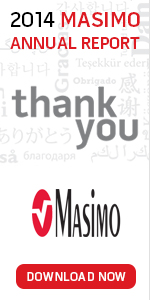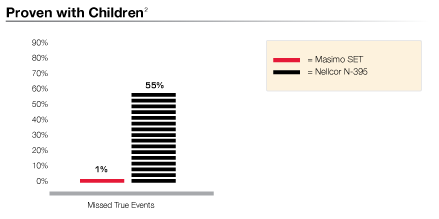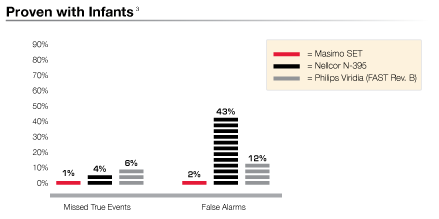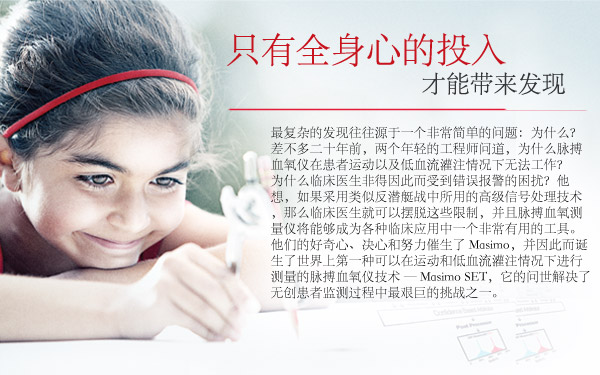
What's the Difference?
What makes Masimo SET different than other (conventional) pulse oximetry?
Conventional pulse oximetry assumes that arterial blood is the only blood moving (pulsating) in the measurement site. During patient motion, the venous blood also moves, which causes conventional pulse oximetry to under-read because it cannot distinguish between the arterial and venous blood. Masimo SET signal processing identifies the venous blood signal, isolates it, and using adaptive filters, cancels the noise and extracts the arterial signal. It then reports the true arterial oxygen saturation and pulse rate.
Conventional Pulse Oximetry provides inaccurate monitoring or signal dropout during:
- Patient Motion or Movement
- Low Perfusion (low signal amplitude)
- Intense Ambient Light (lighting or sunlight)
- Electrosurgical Instrument Interference
Masimo SET pulse oximetry works accurately where conventional pulse oximetry tends to fail. More than 100 independent and objective peer-reviewed clinical studies published and presented in internationally respected forums and numerous additional studies in progress document the significantly superior performance of Masimo SET Pulse Oximetry. The technical innovations that are the basis of the Masimo SET Pulse Oximetry system and Masimo LNOP® SpO2 sensors are addressed by approximately 200 patents issued and pending in the United States and other key countries.
![]()
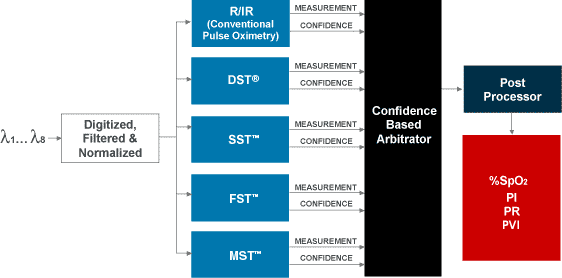
Masimo SET uses Adaptive Filters DST, SST, FST and MST, in parallel processing mode (all patented by Masimo). Masimo SET's four unique algorithms, along with conventional red over infrared algorithm allows for unprecedented fidelity, sensitivity and specificity. Patient data is presented to the set of algorithms. Each algorithm's unique strengths are leveraged to ensure accurate readings through all patient conditions.
Masimo SET’s most powerful algorithm is DST. All algorithms depend upon assumptions. The more assumptions, the weaker the algorithm. DST makes only one assumption—that arterial blood has a higher oxygenation than venous—making it the most powerful pulse oximetry algorithm.
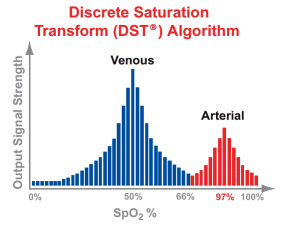
Clinical Studies
Independent clinical studies show Masimo SET is the leading SpO2 technology. It outperforms other pulse oximeters on patients with motion or movement, patients with low perfusion and under difficult conditions.
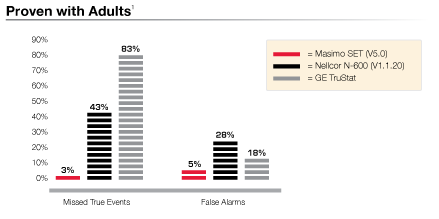 |
| This study measured the occurrence rate of missed true events during 40 low blood-oxygen episodes and false alarms during 120 fully oxygenated episodes, both during conditions of motion. |
|
| This study measured missed true desaturation events out of 75 true events on 5 children undergoing evaluation for sleep-disordered breathing. |
|
| This study measured missed true events and false alarms over a 28 hour period, comparing Masimo SET to other “motion- resistant” pulse oximetry technologies. |
- 1 Nitin Shah, M.D., Laverne Estanol, M.S. Anesthesiology, 2006 Long Beach VA Medical Center, UC Irvine Medical Center, Long Beach, California Comparison of Three New Generation Pulse Oximeters During Motion & Low Perfusion in Volunteers
- 2 Brouillette RT, Lavergne J, Leimanis A, Nixon GM, Laden S, McGregor CD. Differences in Pulse Oximetry Technology can Affect Detection of Sleep Disordered Breathing in Children. Anesth Analg 2002; 94:S47-S53
- 3 Hay WW, Rodden DJ, Collins SM, Melara DL, Hale KA, Fashaw LM. Reliability of conventional and new oximetry in neonatal patients. Journal of Perinatology. 2002; 22:360-266






